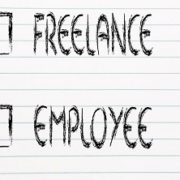Distinguishing between Independent Contractors or Employees; Don’t Let Mislabeling Cost You
Employers have several tax obligations related to their employees. They are expected to withhold income taxes and social security and Medicare taxes from their employees’ pay in addition to paying unemployment tax on their wages. On the other hand, employers have no tax obligations on payments they make to independent contractors. Whether or not you use the services of independent contractors or employees depends entirely upon your business needs, but it is critical that you know the difference between these two very different types of workers.
Employers have several tax obligations related to their employees. They are expected to withhold income taxes and social security and Medicare taxes from their employees’ pay in addition to paying unemployment tax on their wages. On the other hand, employers have no tax obligations on payments they make to independent contractors. Whether or not you use the services of independent contractors or employees depends entirely upon your business needs, but it is critical that you know the difference between these two very different types of workers.
Basically, under common law rule, an independent contractor is someone who provides service to your business and whose method of working you cannot control. You only have the right to control or direct the result of his or her work. According to the IRS, you are working with an independent contractor when you cannot control “what will be done and how it will be done.” Anyone who performs a service for your business is an employee, if you can control what will be done and how it will be done.
With the many different kinds of trades, services, and business arrangements available across the many industries in our market, there are some workers who just do not seem to fit perfectly into any one category of either employee or independent contractor.
To complicate the matter even further, certain kinds of independent contractors may also be considered statutory employees for tax purposes. An example of this kind of service provider is a life insurance sales agent who works full-time and who chooses to sell life insurance or annuity contracts for one particular life insurance company. In the same vein, certain workers may be considered statutory non-employees.
Determining the Type of Individuals Performing Services:
Independent Contractor – A self-employed individual who performs a service or creates a product for a business, but the business cannot control or direct how the work is done is an independent contractor. Typically doctors, dentists, veterinarians, lawyers, accountants, contractors, subcontractors, public stenographers and auctioneers fall into this category.
Employee (common-law employee) –Anyone who performs services for a business by controlling what will be done and how it will be done.
Statutory Employee – Even if workers are independent contractors under the common law rules, such workers may still be treated as employees by statute for certain employment tax purposes. If they fall under one of four scenarios and meet three conditions under the Social Security and Medicare taxes, then you may still need to treat them as an employee for tax purposes.
- Drivers distributing beverages (other than milk) or meat, vegetables, fruit, or bakery products; or who pick up or deliver laundry or dry cleaning, if the driver is your agent or is paid on commission.
- A full-time life insurance sales agent whose principal business activity is selling life insurance or annuity contracts, or both, primarily for one life insurance company.
- An individual who works at home on materials or goods that you supply and that must be returned to you or to a person you name, if you also furnish specifications for the work to be done.
- A full-time traveling or city salesperson that works on your behalf and turns in orders to you from wholesalers, retailers, contractors, or operators of hotels, restaurants, or other similar establishments. The goods sold must be merchandise for resale or supplies for use in the byer’s business operation. The work performed for you must be the salesperson’s principal business activity.
Social Security and Medicare Taxes
Employers should withhold Social Security and Medicare taxes from the wages of a statutory employee if all three of the following conditions apply:
- The service contract states or implies that substantially all the services are to be performed personally by them.
- They do not have a substantial investment in the equipment and property used to perform the services.
- The services are performed on a continuing basis for the same payer.
Statutory Nonemployee: Believe it or not, there are three categories of statutory nonemployees, too: direct sellers, licensed real estate agents and certain companion sitters. The first two categories, direct sellers and licensed real estate agents are treated as self-employed for all federal tax purposes including income and employment taxes, if:
- Substantially all payments for their services as direct sellers or real estate agents are directly related to sales or other output, rather than to the number of hours worked, and
- Their services are performed under a written contract providing that they will not be treated as employees for Federal tax purposes.
Conversely, companion sitters who are not employees of a companion sitting placement service are generally treated as self-employed for all federal tax purposes.
Government Worker: In most cases, individuals who serve as public officials are government employees. In this situation, the individual is an employee of the government and the government entity is responsible for withholding and paying Federal income tax, social security, and Medicare taxes.
Still confused?
There are generally three common law categories that can be used to help you distinguish the type of business relationship you have with your worker and whether or not he or she is an independent contractor or an employee. They are behavioral, financial, and type of relationship – and they highlight the levels of control and independence in the business relationship.
Behavioral – Consider whether you have the right to control what your worker does and how he or she gets the job done.
Financial – Do you control all the business aspects of the job, such as supplying tools and materials, or deciding how the worker is paid, and whether or not expenses are reimbursed?
Type of relationship – Are there written contracts or benefits established, such as a pension plan, leave pay, or insurance? Is it an ongoing relationship that facilitates a key service to the business?
While the IRS provides extensive guidance on determining a worker’s status, there is no strict black and white, easy-delineation; you are encouraged to look at the entire business relationship to come to an understanding. If after you have looked into the situation thoroughly and you still have doubts, you can get help from the IRS by filing Form SS-8, Determination of Worker Status for Purposes of Federal Employment Taxes and Income Tax Withholding. The IRS will look over the data and officially identify the worker’s status for you.
If you’re still unsure, it may be time to solicit the assistance of a small business advisor. Visit the Find an Accountant tab to locate a small business accountant, enrolled agent or tax advisor near you.
PASBA member accountants bring the collective resources of a nationwide network of Certified Public Accountants, Public Accountants, Enrolled Agents and other practitioners available to answer your tax and financial questions and streamline your business accounting, bookkeeping, and payroll operations.
To find a trusted accountant in your area, visit www.SmallBizAccountants.com.
Please be advised that, based on current IRS rules and standards, any advice contained herein is not intended to be used, nor can it be used, for the avoidance of any tax penalty that the IRS may assess related to this matter. Any information contained in this article, whether viewed or subsequently printed, cannot be relied upon as qualified tax and accounting advice. Any information contained in this article does not fall under the guidelines of IRS Circular 230.





